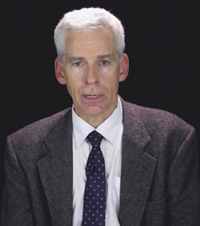 |
NEW WEBSITE: FORUM FOR A NEW PARADIGM
Glass-Steagall, NAWAPA: The Fight in Canada
by Robert Hux
July 2013
 Robert Hux.
|
[This article in PDF format, from EIR]
Robert Hux, Ph.D., is a member of Committee for the Republic of Canada, the LaRouche association in Canada.
I would like to thank Helga and Lyndon LaRouche for inviting me to say a few words, and I’d like to greet the attendees at the Schiller Institute’s fifth conference on the battle to establish a New Paradigm for Mankind, there in San Francisco.
I’d like to begin, first, by mentioning the intervention of the Committee for the Republic of Canada, going back several months, into our nation’s capital in Ottawa, where we’ve been meeting Canadians on the streets of Ottawa, and also in face-to-face meetings with both Members of Parliament and in some cases with Senators. And what we’re discussing is what you’re discussing there at the conference, in terms of Glass-Steagall, and more importantly, what will follow after Glass-Steagall, in particular the North American Water and Power Alliance (NAWAPA).
Now, I have to say that what we found, is that in the case of several of these Members of Parliament and their aides, once they got the picture that perhaps Glass-Steagall is something that needs to happen, we saw that they went through a process of shakeup in some of their axioms. For example, one aide to a Member of Parliament asked, “Well, does this mean that you actually want to develop the Arctic? You’re going to be totally changing the environment!” But this is exactly what we have to do.
People, I’m sure, are aware that right now in the Prairie Provinces of Canada and extending also into the Dakotas, you have very unusual flooding, in Calgary and elsewhere. Now, this is an area that often, in the case of the Saskatchewan River, has not enough water. We’re told that there’s not enough water, so you can’t have allocations of water for agriculture, for industry; we’re also told that, in cases like we have now, when you have too much water, there’s nothing you can do about it.
This is the sentiment behind a bill that has just been passed into law in Ottawa, called Bill C. 383, the so-called “Trans-Boundary Water Protection Act,” which prohibits the construction of projects which would increase the flow of water into the United States via international rivers. Taken together with existing legislation prohibiting bulk water transfers out of the Great Lakes Basin and inter-basin transfers, the intention is not only to prevent large-scale water transfers to the United States and Mexico, as envisioned in NAWAPA, but to declare the vast majority of Canada’s abundant water resources which flow northwards into the Arctic Ocean and Hudson Bay, or westward into the Pacific Ocean, inaccessible even to most Canadians who live within a few hundred miles of the international border.
Although we may not have all the details yet, it is clear that this genocidal policy is being orchestrated by the same British Crown networks which we and, even more so, our Australian counterparts in the Citizen Electoral Council, have exposed for their destruction of the Canadian and Australian Wheat Boards, and the destruction of Australia’s most productive agricultural region, the Murray Darling Basin.
So while there is no denying that we have a fight on our hands, I think that the present conditions of weather extremes that we are witnessing in the prairies, is making the point to even some people in our nation’s capital that we are not in trouble because of too much human activity, but too little.
U.S.-Canadian Cooperation on Great Projects
I would like to also address people at the conference, particularly people that are from the Northwest of the United States, or California, to make them aware that there has been a history of collaboration between the United States and Canada, on subjects bearing on NAWAPA. For example, the development in the United States of the Lower Columbia River for hydroelectric generation; flood control and irrigation which began in the 1930s under Franklin Roosevelt, immediately generated a lot of interest in Canada in doing the same thing on the Upper Columbia River, which has its origin in the Rocky Mountain Trench of British Columbia. While there is no time here for the full story,1 the Columbia River Treaty was finally signed in January 1961 by President Eisenhower and Prime Minister John Diefenbaker.
This U.S.A.-Canada treaty was a victory for the idea of developing the hydroelectric storage dams on the Upper Columbia River in a way which would mutually benefit both nations, and a defeat of the proposal of Anglophile Gen. Andrew McNaughton, the Canadian chairman of the International Joint Commission (1950-62), who proposed to divert the Columbia and Kootenay Rivers into the Fraser River, with the sole view of producing hydroelectric power for British Columbia, and providing water to irrigate the Canadian Prairies.
But this was not the end of the story, because the 1961 version of the Columbia River Treaty (CRT) said that British Columbia’s entitlement to one half of the increased power generation downstream, due to the construction of the CRT dams, could not be sold in the U.S. on a long-term contract, but must be sent back into the province.
This created a problem for the Premier of British Columbia, W.A.C. Bennett, who was committed to the economic development of B.C.’s sparsely populated interior regions, powered by, not only, the hydroelectric potential of the Columbia River, but at the same time, that of the Peace River. Bennett’s battle for the conditions required for his “Two Rivers Policy,” which would go on for another three years before the final ratification of the Columbia River Treaty by the British Columbia legislature, led him, in November 1961, to risk a diplomatic incident, by flying down to Seattle, and seeking the support of President John F. Kennedy in a private closed-door meeting.
Although Bennett never, to my knowledge, publicly embraced the idea of large-scale water exports, the Columbia River and Peace River dams, which he was responsible for building, are linchpins in the proposed development of NAWAPA; the Peace River being the place from which you would divert water that normally would flow northward into the Arctic, in the Mackenzie River Basin; you would divert water eastward into the Saskatchewan River Basin, into the areas that, unlike now, are often very arid and require extra water. And some of this water could also be made available into the Dakotas, into the Missouri River System, into the Mississippi River. The Columbia River Treaty dams are part of the design which could deliver water southwards into the United States via the Rocky Mountain Trench.
So, you have this history of collaboration.
Also, if you look at the mid-1960s, right after the North American Water and Power Alliance had been put forward, you see a study conducted by the three Canadian prairie provinces and the Canadian government, under the Saskatchewan-Nelson River Basin Board, that asked the question: How much water would become available in this basin (this is the basin that is flooding right now), if we were to build up to 55 new dams, and consider up to 23 river diversions (including inter-basin diversions)?
So if you look at the plans that they were looking at, this is actually going through elements of NAWAPA.
This openness to collaborate with the United States on these areas, that could have allowed us to begin to solve the problems that you now have in this area, was there.
So, with that, I look forward to collaborating with people there, on what we have to do to make this happen.
Thank you.
1. See Matt Ehret-Kump, “W.A.C. Bennett: Canada’s Spiritual Father of NAWAPA,” The Canadian Patriot, No. 4, January 2013; pp. 13-25 (www.comiterepubliquecanada.ca).
